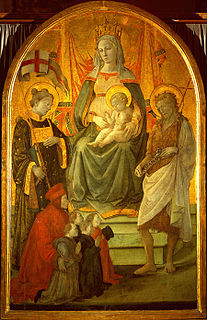 W
WAdoration of the Christ Child is a tempera on panel altarpiece by Filippo Lippi, originally painted for the church of San Domenico in Prato and now in the city's Museo Civico. It is also known as Adoration of the Christ Child with St Vincent Ferrer or Nativity with St George and St Vincent Ferrer. It was painted between 1455 and 1466. The work was probably damaged by a fire in the church in 1467, requiring some repairs which were discovered in a recent restoration of the work.
 W
WThe Barbadori Altarpiece is a painting by Filippo Lippi, dated to 1438 and housed in the Louvre Museum of Paris.
 W
WThe Bartolini Tondo is a tempera on panel painting by Filippo Lippi. 135 cm in diameter, it is also known as Madonna with the Child and Scenes from the Life of St Anne or Madonna and Child with the Birth of the Virgin and the Meeting between St Joachim and St Anne. It is now in the Galleria Palatina in the Palazzo Pitti in Florence - the work is mentioned in the Palazzo Pitti inventories in 1761, which mention it as being stored or displayed in the "soffitte" or attics.
 W
WThe Madonna del Ceppo is a painting by the Italian Renaissance painter Filippo Lippi, commissioned to him between 1452 and 1453. It is housed in the Civic Museum of Prato, Italy. The name derives from the fact that it was located over a pit of the garden of Pia Casa dei Ceppi in Palazzo Datini, in Prato.
 W
WThe Triptych of the Madonna of Humility with saints is an altarpiece by Filippo Lippi, produced around 1430. It has been in the Fitzwilliam Museum in Cambridge since 1893. Its central panel shows the Madonna as the Madonna of humility. Its left panel shows John the Baptist, whilst its right panel shows Saint George or Saint Ansanus.
 W
WThe Novitiate Altarpiece or Madonna and Child with Saints is a c.1440-1445 tempera on panel painting by Filippo Lippi, now in the Uffizi in Florence. A sacra conversazione, it originally had a predella painted by Pesellino centred on a Nativity. The main panel shows Cosmas and Damian either side of the Madonna and Child, whilst Francis of Assisi is shown at far left and Anthony of Padua at far right. On an architectural frieze above the figures are the Medici's heraldic balls.
 W
WThe Madonna of Palazzo Medici-Riccardi is a painting by the Italian Renaissance artist Filippo Lippi. It is housed in the Palazzo Medici-Riccardi of Florence, central Italy.
 W
WMadonna and Child is a c. 1450-1455 tempera on panel painting by Filippo Lippi, now in the Magnani-Rocca Foundation in the Province of Parma in Italy. It is strongly influenced by Flemish works, particularly in the trompe l'oeil marble banister and the drape over the dark background. It also shows some similarities to the work of the Master of the Castello Nativity, who is thought to have been an assistant in Lippi's workshop.
 W
WThe Enthroned Madonna and Child is a painting by the Italian Renaissance painter Filippo Lippi. It is housed in the Galleria Nazionale d'Arte Antica of Palazzo Barberini, Rome.
 W
WMadonna with Child is a painting by the Italian Renaissance artist Filippo Lippi. The date in which it was executed is unknown, but most art historians agree that it was painted during the last part of Lippi's career, between 1450 and 1465. It is one of the few works by Lippi which was not executed with the help of his workshop and was an influential model for later depictions of the Madonna and Child, including those by Sandro Botticelli. The painting is housed in the Uffizi Gallery, Florence, Italy, and is therefore commonly called “The Uffizi Madonna” among art historians.